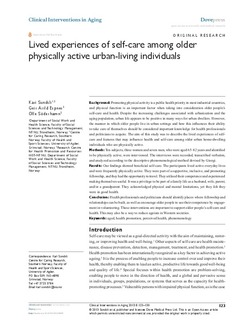| dc.contributor.author | Sundsli, Kari | |
| dc.contributor.author | Espnes, Geir Arild | |
| dc.contributor.author | Söderhamn, Olle | |
| dc.date.accessioned | 2013-05-03T12:05:34Z | |
| dc.date.available | 2013-05-03T12:05:34Z | |
| dc.date.issued | 2013 | |
| dc.identifier.citation | Sundsli, K., Espnes, G. A., & Soderhamn, O. (2013). Lived experiences of self-care among older physically active urban-living individuals. Clinical Interventions in Aging, 8, 123-130. doi: 10.2147/cia.s39689 | no_NO |
| dc.identifier.issn | 1176-9092 | |
| dc.identifier.uri | http://hdl.handle.net/11250/139049 | |
| dc.description | Published version of an article in the journal: Clinical Interventions in Aging. Also available from the publisher at: http://dx.doi.org/10.2147/cia.s39689 Open access | no_NO |
| dc.description.abstract | Background: Promoting physical activity is a public health priority in most industrial countries, and physical function is an important factor when taking into consideration older people's self-care and health. Despite the increasing challenges associated with urbanization and the aging population, urban life appears to be positive in many ways for urban dwellers. However, the manner in which older people live in urban settings and how this influences their ability to take care of themselves should be considered important knowledge for health professionals and politicians to acquire. The aim of this study was to describe the lived experiences of self-care and features that may influence health and self-care among older urban home-dwelling individuals who are physically active. Methods: Ten subjects, three women and seven men, who were aged 65-82 years and identified to be physically active, were interviewed. The interviews were recorded, transcribed verbatim, and analyzed according to the descriptive phenomenological method devised by Giorgi. Results: Our findings showed beneficial self-care. The participants lived active everyday lives and were frequently physically active. They were part of a supportive, inclusive, and promoting fellowship, and they had the opportunity to travel. They utilized their competence and experienced making themselves useful. It was a privilege to be part of a family life as a husband, wife, parent, and/or a grandparent. They acknowledged physical and mental limitations, yet they felt they were in good health. Conclusion: Health professionals and politicians should identify places where fellowship and relationships can be built, as well as encourage older people to use their competence by engagement in volunteering. These interventions are important to support older people's self-care and health. This may also be a way to reduce ageism in Western societies. | no_NO |
| dc.language.iso | eng | no_NO |
| dc.publisher | Dovepress | no_NO |
| dc.subject | aged | no_NO |
| dc.subject | health promotion | no_NO |
| dc.subject | perceived health | no_NO |
| dc.subject | phenomenology | no_NO |
| dc.title | Lived experiences of self-care among older physically active urban-living individuals | no_NO |
| dc.type | Journal article | no_NO |
| dc.type | Peer reviewed | no_NO |
| dc.subject.nsi | VDP::Medical disciplines: 700::Clinical medical disciplines: 750::Geriatrics: 778 | no_NO |
| dc.subject.nsi | VDP::Medical disciplines: 700::Health sciences: 800 | no_NO |
| dc.source.pagenumber | 123-130 | no_NO |
| dc.source.volume | 8 | no_NO |
| dc.source.journal | Clinical Interventions in Aging | no_NO |
| dc.identifier.doi | 10.2147/cia.s39689 | |
